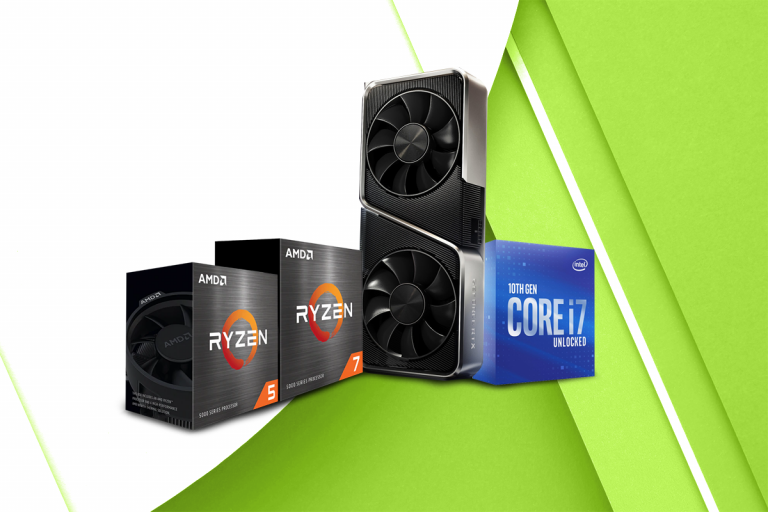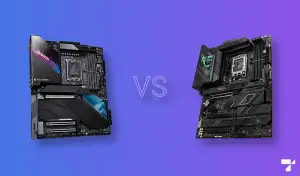Nvidia made a giant leap with their Ampere technology, massively boosting the performance of their RTX 3000 series graphics cards. We gained a lot in terms of performance to value compared to the 2000 series GPUs, especially when looking at the RTX 3070. But, if you are looking to build a PC with the RTX 3070, you’ll need to pair it with a good processor. Therefore, in this article, we have reviewed the best CPUs for RTX 3070.
The RTX 3070 is just as impressive, especially when looking at the price. This mid-range GPU manages to compete and even slightly surpass Nvidia’s old-gen flagship, the RTX 2080 TI, at less than half the price. With 5,888 CUDA cores, 8GB of GDDR6 memory, and a boost clock of 1,73 MHz, the RTX 3070 becomes one of the top choices for 1440p gaming. Besides, it also supports the next-gen PCIe 4.0 interface and RTX I/O technology, which together will improve the speed of data transmission and reduce loading times.
With that in mind, if your current CPU supports PCIe 3.0 or it’s anything older than an i7-4770k, you should replace it before getting the RTX 3070. Having such an old system may bottleneck the GPU and you won’t be able to take full advantage of some of its features that boost data transfer rates. So, let’s take a look at a list of CPUs that won’t bottleneck your system and that are future-proof when paired with the RTX 3070.
Best Processors for RTX 3070
1. AMD Ryzen 5 5600X
Specifications
Architecture: Zen 3 | Socket: AM4 | Cores/Threads: 6 / 12 | Base Frequency: 3.7GHz | Top Boost Frequency: 4.6GHz | TDP: 65WKey Features
- PCIe 4.0 for better graphics and storage bandwidth
- 7nm architecture
- 35MB total cache
- Wraith Prism Cooler with Razer Chroma support included
- AMD Ryzen Master Utility for simple overclocking
- AMD StoreMI technology
With the announcement of the new Zen 3 architecture, AMD promised solid performance boosts and high gaming speeds. So far, it seems that the Ryzen 5 5600X delivers on those promises.
Like its predecessor, the Ryzen 5 3600X, the 5600X is a 6-core processor with a base clock speed of 3,7GHz that can reach a maximum boost clock speed of 4,6GHz. While the two CPUs are similar, the Zen 3 version pulls off an additional 200MHz. These stats are similar to those of Intel’s i5-10600K processor, but the latest benchmarks show that the 5600X manages to pull ahead thanks to the improved architecture. Furthermore, the 5600X is also more power-efficient.
The 5600X comes at a higher price than its predecessor, but it can even be used in 4K systems. At this resolution, the GPU matters a lot more than the CPU, but it’s important not to bottleneck the RTX 3070 by using an old processor. Besides, the 5600X offers PCIe 4.0 support, just like the RTX 3000s series and AMD’s B550 and X570 motherboards.
Ultimately, the Ryzen 5 5600X CPU is an impressive CPU both for gaming and multitasking. If you plan on building a new system around the RTX 3070, this processor is more than adequate.
2. AMD Ryzen 7 5800X
Specifications
Architecture: Zen 3 | Socket: AM4 | Cores/Threads: 8 / 16 | Base Frequency: 3.8GHz | Top Boost Frequency: 4.7GHz | TDP: 105WKey Features
- PCIe 4.0 for better graphics and storage bandwidth
- 7nm architecture
- 36MB total cache
- AMD StoreMI technology
- AMD Ryzen Master Utility for simple overclocking
The Ryzen 7 5800X is probably the most exciting Zen 3 processor because it hits the sweet spot when it comes to the performance/value ratio. Most gamers won’t need more than 8 cores to build a future-proof PC and to enjoy modern games in 4K. Demanding applications will also benefit from the thread count and the improvements AMD made to the IPC. On a side note in case you don’t know, IPC refers to the number of tasks that the CPU can process during a single cycle. So, the 5800X is also a great choice if you’re doing some rendering or using serious applications.
When it comes to gaming performance, we expect to see improved loading times when taking full advantage of the PCIe 4.0 support and the processor can be easily overclocked up to 4,7GHz through AMD’s Ryzen Master Utility. Also, the StoreMI software is also supported by the 5800X as long as the motherboard supports it. This tool allows us to improve the performance of our storage systems and enhance data integrity.
In essence, the Ryzen 5800X is going to be a mainstream CPU that can handle intense workloads. If you’re planning a new PC build, especially with the RTX 3070 GPU, the 5800X is a rock-solid choice.
3. Intel Core i7-10700K
Specifications
Architecture: Comet Lake | Socket: LGA 1200 | Cores/Threads: 8 / 16 | Base Frequency: 3.8 GHz | Top Boost Frequency: 5.10 GHz | TDP: 125WKey Features
- Can be overclocked up to 5.1 GHz using Turbo Boost Max 3.0
- Hyper-Threading technology
- Easy to use overclocking controls
- Intel Optane Memory support
Intel’s 10700K processor is closer to the i9-9000K than anything else. Both chips have 8 cores and 16 threads, but the i7 is significantly cheaper. Furthermore, the base clock is at an impressive 3.8 GHz, which is slightly higher than many competing chips. What’s impressive is the fact that we can boost that frequency up to 5.10 GHz as long as we have a solid PSU and a serious cooling system. No stock or cheap cooler can handle that much power.
On the downside, the i7-10700K lagged a bit behind the Zen 2 and 3 series from AMD and it only supports PCIe 3.0. While the processor itself is a powerful beast when it comes to raw power, without the next-gen PCIe 4.0 interface we’ll be missing out in the near future.
4. AMD Ryzen 9 5900X
Specifications
Architecture: Zen 3 | Socket: AM4 | Cores/Threads: 12 / 24 | Base Frequency: 3.7GHz | Top Boost Frequency: 4.78GHz | TDP: 105WKey Features
- PCIe 4.0 for better graphics and storage bandwidth
- 7nm architecture
- 70MB total cache
- AMD StoreMI technology
- AMD Ryzen Master Utility for simple overclocking
The 5900X is aimed towards the mainstream high-end gamer who wants to get as much performance as possible out of his system. With 12 cores, a 4.8GHz boost clock, and a 70MB cache (L2 + L3), this Zen 3 processor is nearly identical to its Zen 2 counterpart. They even have the same 105W power requirement. But the 5900X still comes well ahead of its predecessor due to the improved architecture and it’s an ideal choice for demanding applications and gaming at 4K. However, keep in mind that in most cases having a processor with more than 8 cores is overkill, especially when it comes to gaming.
With that being said, the 5900X is everything you want out of a processor and more. It’s powerful, versatile, and future-proof thanks to the PCIe 4.0 support and AMD’s StoreMI feature that improves data transfers.
5. AMD Ryzen 7 3700X
Specifications
Architecture: Zen 2 | Socket: AM4 | Cores/Threads: 8 / 16 | Base Frequency: 3.6 GHz | Top Boost Frequency: 4.40 GHz | TDP: 65WKey Features
- PCIe 4.0 for better graphics and storage bandwidth
- 7nm technology
- 36MB total cache
- Wraith Prism Cooler with Razer Chroma support included
The 3700X is a Zen 2 processor that is still an excellent choice despite the launch of the Zen 3 series. Even though there’s an architectural difference, the 3700X offers PCIe 4.0 support as well, so it won’t bottleneck the system any time soon. Having 8 cores and a potential boost clock of 4.40 GHz, this processor is going to be enough for most gamers, especially when used together with the RTX 3070. Also, it has a very low power requirement of 65W, allowing us to save on the PSU. Other CPUs in its class demand anywhere between 105W to 125W.
In essence, the Ryzen 7 3700X comes with all the modern features, like the PCIe 4.0 interface, it supports 4K gaming, and it’s not going to break your budget. And unlike other mainstream CPUs, the 3700X also comes with the decent Wraith Prism Cooler included, so no need to invest in an after-market cooler unless you overclock it to the limit.
6. AMD Ryzen 9 3900X
Specifications
Architecture: Zen 2 | Socket: AM4 | Cores/Threads: 12 / 24 | Base Frequency: 3.8GHz | Top Boost Frequency: 4.60GHz | TDP: 105WKey Features
- PCIe 4.0 for better graphics and storage bandwidth
- 7nm technology
- 70MB total cache
- Wraith Prism Cooler with Razer Chroma support included
The 3900X is a high-end Zen 2 processor that competes with the i9-9900K chip from Intel. With 12 cores, a boost frequency up to 4.6GHz, and PICe 4.0 support, the 3900X is still a powerful and versatile bit of hardware despite the release of the new Zen 3 line of processors. It’s more than capable of handling a gaming system built around the RTX 3070, and it’s one of the best choices for demanding tasks, such as 3D modeling and rendering. The 3900X excels at multi-threaded workloads.
On the downside, single-core performance isn’t as great compared to what other processors like the 9900K have to offer. Many games are still single-threaded so it’s worth keeping this in mind, however, this is already changing and more and more games benefit from a high thread count. Furthermore, while the included Wraith Prism Cooler is great during regular workloads, it can’t handle a boost frequency of 4.6GHz. So, if you plan on squeezing every ounce of performance out of the 3900X, you’ll want a bigger cooling system.
All in all, the 3900X is a beast when it comes to multithreaded operations and it’s future-proof thanks to the PCIe 4.0 support.
7. Intel Core i5-10600K
Specifications
Architecture: Comet Lake | Socket: LGA 1200 | Cores/Threads: 6 / 12 | Base Frequency: 4.10 GHz | Top Boost Frequency: 4.80 GHz | TDP: 125WKey Features
- Turbo Boost 2.0
- Hyper-Threading technology
- New overclocking controls for more efficient tuning
- Intel Optane Memory support
This midrange processor from Intel is a great choice for gaming systems thanks to its strong single-core performance. Intel continues to focus on achieving high clock speeds, despite the 14nm architecture. With an impressive 4.10 GHz base clock, this chip will not bottleneck the RTX 3070’s performance and it will be more than sufficient for 4K gaming.
On the downside, the 10600K doesn’t have PCIe 4.0 support. As modern computer systems and games start taking advantage of that feature, we can’t ignore the fact that this 10th generation i5 is unlikely to be future-proof and an upgrade will be preferable.
8. AMD Ryzen 5 3600X
Specifications
Architecture: Zen 2 | Socket: AM4 | Cores/Threads: 6 / 12 | Base Frequency: 3.8GHz | Top Boost Frequency: 4.4GHz | TDP: 95WKey Features
- PCIe 4.0 for better graphics and storage bandwidth
- 7nm technology
- 35MB GameCache memory for boosted performance
- Wraith Prism Cooler with Razer Chroma support included
The Ryzen 3600X is an absolute steal if you don’t want to go with Intel or with the new Zen 3 processors from AMD. When it comes to gaming, we rarely need something stronger than a 6 core CPU with a 4.4GHz boost frequency. We can even play games at 4K because at that resolution it’s the GPU that does most of the work. In addition, the 3600X also offers PCIe 4.0 support like the more powerful processors in the series.
With that being said, we can safely assume that the 3600X will not bottleneck the RTX 3070 at this time. However, that is likely to change in a few years as games start to take advantage of CPUs with a higher core/thread count.
Final Thoughts
AMD and Intel continue to fiercely compete against each other over everyone’s RTX 3070 system. Competitive gamers, value-seeking PC users, and 3D modelers alike are on the lookout for the ideal CPU. Fortunately, the rivalry between the two companies provides us with a large list of CPUs. So feel free to choose one of the new Zen 3 processors from AMD, a budget-friendly 3600X, or Intel’s famous i7-10700K, among many other options.



